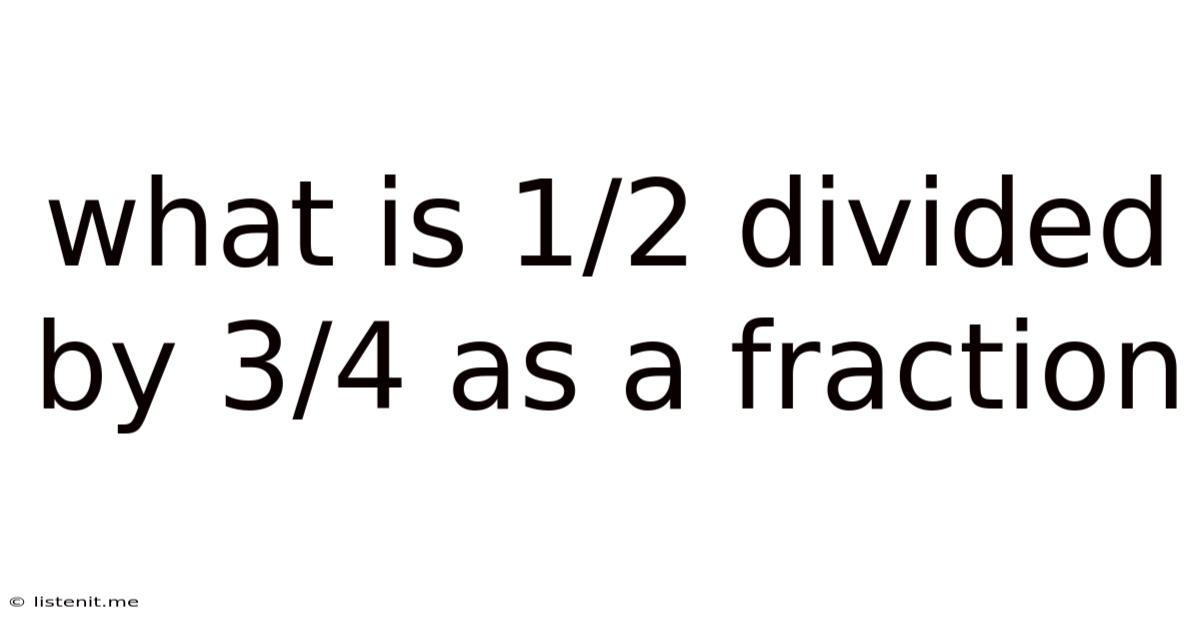What Is 1/2 Divided By 3/4 As A Fraction
listenit
May 12, 2025 · 4 min read

Table of Contents
What is 1/2 Divided by 3/4 as a Fraction? A Comprehensive Guide
Dividing fractions can seem daunting at first, but with a clear understanding of the process, it becomes straightforward. This comprehensive guide will walk you through the steps of solving 1/2 divided by 3/4, explaining the underlying concepts and providing additional examples to solidify your understanding. We'll explore various methods, ensuring you grasp the fundamental principles of fraction division.
Understanding Fraction Division
Before tackling our specific problem (1/2 ÷ 3/4), let's review the core concept of dividing fractions. The key is to remember that dividing by a fraction is the same as multiplying by its reciprocal. The reciprocal of a fraction is simply the fraction flipped upside down. For example, the reciprocal of 3/4 is 4/3.
In essence, the rule for dividing fractions is:
a/b ÷ c/d = a/b * d/c
Where 'a', 'b', 'c', and 'd' represent numbers, and 'b' and 'c' are not zero (as division by zero is undefined).
This rule simplifies the process considerably, transforming a division problem into a multiplication problem, which is generally easier to manage.
Solving 1/2 Divided by 3/4
Now, let's apply this rule to our problem: 1/2 ÷ 3/4.
-
Find the reciprocal of the second fraction (the divisor): The reciprocal of 3/4 is 4/3.
-
Rewrite the division problem as a multiplication problem: 1/2 ÷ 3/4 becomes 1/2 * 4/3.
-
Multiply the numerators (top numbers) together: 1 * 4 = 4
-
Multiply the denominators (bottom numbers) together: 2 * 3 = 6
-
Write the result as a fraction: The result is 4/6.
-
Simplify the fraction (if possible): Both 4 and 6 are divisible by 2. Simplifying, we get 2/3.
Therefore, 1/2 divided by 3/4 is equal to 2/3.
Visualizing the Division
Understanding fraction division can be enhanced by visualizing it. Imagine you have 1/2 of a pizza. You want to divide that 1/2 pizza into portions that are each 3/4 the size of a whole pizza. How many 3/4-sized portions can you get from your 1/2 pizza? The answer, as we've calculated, is 2/3 of a portion. It's less than one full 3/4 portion because your starting amount (1/2 pizza) is smaller than the portion size you're dividing it into (3/4 pizza).
Alternative Methods
While the reciprocal method is the most efficient, other approaches can help solidify your understanding:
Method 1: Using Common Denominators
This method involves finding a common denominator for both fractions before dividing. While less efficient than the reciprocal method for simple problems, it's useful for understanding the underlying logic.
-
Find a common denominator for 1/2 and 3/4: The least common denominator is 4.
-
Rewrite the fractions with the common denominator: 1/2 becomes 2/4, and 3/4 remains 3/4.
-
Divide the numerators: 2 ÷ 3 = 2/3.
This method provides the same result: 2/3.
Method 2: Converting to Decimals (Less Precise)
You can convert the fractions to decimals and then divide. This method is less precise because decimal representations of fractions can be non-terminating (e.g., 1/3 = 0.333...).
-
Convert 1/2 to a decimal: 1/2 = 0.5
-
Convert 3/4 to a decimal: 3/4 = 0.75
-
Divide the decimals: 0.5 ÷ 0.75 ≈ 0.666...
This approximates to 2/3, demonstrating the equivalence. However, using decimals can lead to rounding errors, making the fraction method more reliable for accuracy.
Practice Problems
To reinforce your understanding, try solving these similar problems using the reciprocal method:
-
2/5 ÷ 1/3 = ? (Hint: The reciprocal of 1/3 is 3/1 or 3)
-
3/8 ÷ 5/6 = ?
-
1 1/2 ÷ 2/3 = ? (Remember to convert mixed numbers to improper fractions first: 1 1/2 = 3/2)
-
5/7 ÷ 1 1/4 = ? (Convert 1 1/4 to an improper fraction before solving)
Further Exploration: Complex Fractions
The concept of dividing fractions extends to complex fractions, where the numerator or denominator (or both) contains fractions. For example:
(1/2) / (3/4)
This is essentially the same as our original problem and is solved using the same method (reciprocal).
Conclusion
Dividing fractions, while initially seeming complex, becomes manageable with a clear understanding of the reciprocal method. By consistently applying the rule of multiplying by the reciprocal, you can accurately and efficiently solve any fraction division problem. Remember to simplify your final answer whenever possible for a clean and concise result. Practice is key to mastering this fundamental mathematical skill. The visual representation and alternative methods offered here provide a multi-faceted approach to solidify your comprehension. Don't hesitate to work through the practice problems to build confidence and fluency in dividing fractions.
Latest Posts
Latest Posts
-
Which Element Has The Greatest Atomic Radius
May 12, 2025
-
Which Noble Gas Has The Highest First Ionization Energy
May 12, 2025
-
Why Do Isotopes Have The Same Chemical Properties
May 12, 2025
-
Which Element Will Have The Smallest Atomic Radius
May 12, 2025
-
Do Metals Tend To Gain Or Lose Electrons
May 12, 2025
Related Post
Thank you for visiting our website which covers about What Is 1/2 Divided By 3/4 As A Fraction . We hope the information provided has been useful to you. Feel free to contact us if you have any questions or need further assistance. See you next time and don't miss to bookmark.